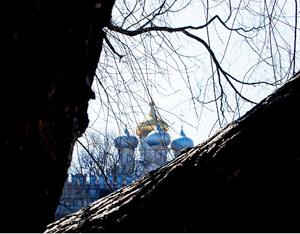The Real Moscow
By B. Kim Barnes
The real Moscow rides the Metro. Young, old, poor and middle-class, cheek to jowl. I did not spot any of the oligarchs. For that matter, one difference between the Moscow Metro and the London Tube or NY subway, Boston’s MTA, the Metro in Paris or San Francisco’s BART is that people tend to either read or sleep, as used to be true on those conveyances. Very few people wear earphones—one young man was holding a portable CD player, one was using an iPhone—but most people were just busy not making eye contact. Of course, cell phones are ubiquitous here as everywhere and are useful for that purpose.

Several times I saw a young man gave up his seat to a person with white hair—including me. Good manners are not dead here. The Metro seems to be crowded at all hours of the day. It is a beautifully designed system and it is full all the time. It is very efficient and the stations are often architecturally and artistically magnificent. There is no obvious security, but oddly—unlike other European countries—I have seen NO women in Islamic dress – not on the Metro, not on the streets. Any woman wearing black clothing and a head covering is a Russian Orthodox nun. I am not sure if that is due to special security or whether Islamic women fear to come out after the recent incident. I feel very sorry for anyone who might be mistaken for one of the “Black Widows”—the young Chechen women who take up their dead husbands’ cause and blow things up.
As I was puzzling over how to get from one line to another in a rather confusing and busy station, a man about my age came along and asked if he could help me find something. His English was not too bad; he looked like he had once been an accountant or a teacher. I was not surprised by his offer, as people are generally very helpful to strangers here. He escorted me to my train, all the while talking bitterly about life as a pensioner. When we got to the right place, he asked me for some money in exchange for the guide services. I was rather expecting this after the conversation—but could imagine how painful this act must have been to a man who once had total security and the dignity of guaranteed work. The contrast with the wealthy, successful, and beautiful young people could not have been more clear. The other day I spotted, behind the statue of Karl Marx across from the Bolshoi Theater, a small Communist rally complete with red flags—perhaps 15 people; the average age must have been 65.
And speaking of the Bolshoi, I spent far too much money to see Giselle at the new Bolshoi stage. It was stunning. The audience was far more diverse in age, gender, and class than you would see at the SF Ballet—Russians love ballet and know it really well—they clapped as soon as the principal dancers came on stage and when something was executed really well, the rhythmic clapping would not stop until the dancers had acknowledged the tribute. I’m not sure I ever want to see Giselle again—I would like to hold the memory of this magnificent performance.
I visited the beautiful Novadevichy Convent today. It is an exquisite and peaceful place now—but it was built as a fortress and once was a refuge for women of wealthy families during the 16th – 18th centuries. It was founded in 1524 by Tsar Vasily III (1479-1533) to commemorate the capture of Smolensk from Lithuania.
On Sunday, I visited the famous Church of the Ascension in Kolomenskaya, which was constructed in 1529-1532 by order of Tsar Vasily III to commemorate the birth of his son and heir, Ivan the Terrible. It is a magnificent park where some of the wooden architecture has been installed —and where young people whiz along on in-line skates, families take their children to a fun fair, and—lucky for me—people in traditional dress were playing a concert on bells that were sheets of metal hanging on a frame. What gorgeous sounds! There were other churches on the grounds, one of which was conducting a funeral.
Many Russians are deeply religious. The intensity of their faith makes me wonder how they managed during the years of official atheism. It is as if the Russian Orthodox church has won a long-fought battle; churches are rebuilt, restored, well-attended, and the focus of many peoples’ lives. Churches are gorgeous, richly decorated, well-kept. And they are among the most architecturally beautiful buildings imaginable—as a photographer, I find them deeply compelling.
Working here has been fascinating. The two Cisco Exercising Influence groups I worked with were among the most engaged, intelligent, and eager-to-learn classes I have ever had the pleasure to teach. I also had the opportunity to meet the dean of the new and highly innovative Moscow Business School and was most impressed with what they are doing. The “R” of the BRIC countries is on its way to being a powerful player in the business world—their openness to new ideas and skills will be a key to their success.

Dear Kim,
First of all your photos are awesome. I also like the ones on the Barnes&Conti website, which I would guess you took too, since there are of a similar style than the one on this post.
I enjoyed – and learned from – the way you we taking in and observing your surroundings in Moscu, and the way you write about it. Thanks !
I took the 2 day Innovation Management workshop in Caracas, Venezuela last year. Dr. David Francis was there, as well as CENTRIM. I recently moved to the US, I’m on the east coast. I would like to get in contact with you. Couldn’t find your email (or any) on the firm’s website.
Regards,
Juan Pablo Molina